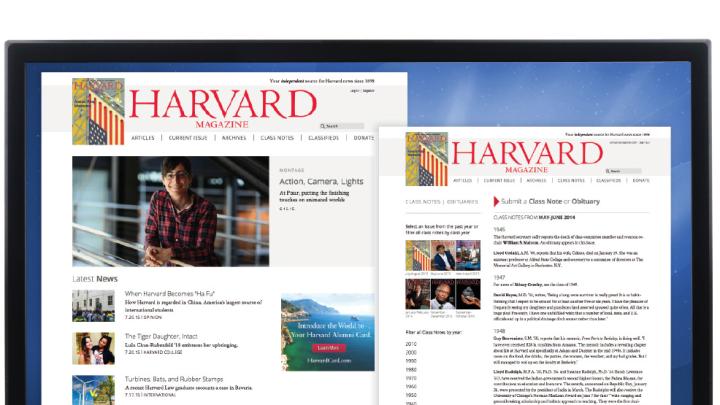For more than a year, a group of Harvard Magazine staffers have collaborated to create a new, streamlined version of harvardmagazine.com. The clean, straightforward design makes the new site much more visual, offering larger images and beautiful photo galleries, as well as dynamic multimedia. New features such as “On Readers’ Radar” and “You Might Also Like” allow visitors to readily view popular articles and easily find content similar to what they’re currently perusing or have recently read.
Other key enhancements include:
- simplified article navigation;
- improved issue-specific contents pages;
- an updated Archives section;
- class notes and obituaries searchable by class year, issue, or name;
- enhanced account management;
- reader-friendly FAQs for staff contacts, subscriptions, directions, and more;
- simple ways to print, save a PDF, or share an article with friends via social media.
Associate web developer Jeff Hudecek implemented the interactive features to precisely match the designs developed by art director Jennifer Carling. At the onset of the project, Hudecek also led “wireframing” meetings to help simplify and organize the site’s content.
Production and new media manager Mark Felton said the functionality of the website was improved in several ways, making it easier to both find and access all content. “The cover of the current issue now appears prominently at the top of every page, and a new, permanent ‘Archives’ link makes it easier to access back issues,” he explained. “We're also proud of the improvements we made to class notes and obituaries. The redesigned interface makes it easier for Harvard and Radcliffe College graduates with a Harvard Magazine account to filter both sections by issue or by class year. In general,” he continued, “wherever we could, we consolidated information into fewer pages. That means fewer clicks to get to the content you’re after.”
The visible design changes reflect substantial enhancements to the website’s back-end functions, Felton emphasized: “We use Drupal, an open-source content-management system, and were able to complete a major version upgrade that we anticipate will allow us to build more features, more quickly, in the future.”
Carling, who led the design effort, said the goal for the new site was to give readers a clean, simple design that allows for greater exploration—with “more white space, improved site navigation and organization, consistent use of color and typography, and enhanced image presentation. We want the design to highlight the content and not compete with it. The greater design consistency throughout will help guide readers as they navigate the site.”
We appreciate any feedback—pro or con—from readers. Please leave your thoughts and suggestions in the comments section below.








